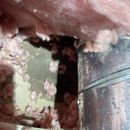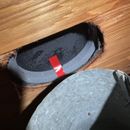Kitchen Exhaust Condensation
Hello,
I live in the St. Louis, MO area (4a) where it’s hot/ultra humid in the summer and can get a few degrees below zero in the winter, which just happened recently.
I’m having an issue with moisture condensating in my kitchen exhaust pipe and leaking onto a drywall ceiling directly below the lowest point in the (currently uninsulated) sloped 6″ rigid pipe run. During a recent cold snap I noticed the telltale brown moisture spots on the ceiling drywall. I’ve lived in the house for 15+ years and never had this occur before, including during previous cold weather.
A few months ago I had my roof replaced and the contractor swapped out what they called a “passive” roof vent with an “exhaust vent” to exhaust the kitchen to the outdoors. I’m pretty sure the existing vent didn’t have a damper and the new one definitely does.
My current microwave/exhaust fan is broken, so it definitely wasn’t run during the recent cold weather. I am planning to replace it with a exhaust hood in the future though, so a properly functioning exhaust pipe detail is needed.
When I went into the attic to investigate the issue, I discovered that the new exhaust vent was taped shut. The roofing crew overlooked a piece of red tape that keeps the damper closed during shipment from the manufacturer to the job site.
My initial reaction was to remove the red tape and insulate the pipe for good measure. But my concern is that won’t solve the problem.
Since I’m currently not running the exhaust fan, there’s nothing to push the damper open. My hypothesis is there isn’t a damper built into the existing microwave/fan end of the run and small amounts of warm moist air naturally go up the pipe, even without running the fan. Previously any warm air was let out the end of the pipe because it’s open to the outside. With the damper being shut at the roof vent whenever the fan isn’t running, the moisture is stuck in the pipe and condensates.
Do I need another damper close to the kitchen end of the piping? Will this freeze up in the winter? I’m actually surprised this hasn’t happened before the vent was swapped out. Thoughts on how to solve this?
Many Thanks,
Paul
GBA Detail Library
A collection of one thousand construction details organized by climate and house part











Replies
I'm not exactly sure of your configuration, but as I understand it, the kitchen exhaust vent goes up and out of the roof, through the vent (with damper) that was replaced by the roofers. With that understanding, your thoughts on cause are probably correct. With the previous configuration, the open exhaust vent was acting like a chimney, with indoor air continuously rising by stack effect adn keeping the metal vent pipe warm enough to avoid condensation. With the closed damper, you are probably getting convection inside the vent pipe, with warm/moist air rising into the pipe, cooling, condensing its moisture out on the pipe, then sinking back down into the house to be replaced by more warm/moist air.
Vent pipes should be installed with the female end at the top and male end at the bottom so that any condensate will drip out the bottom (the hood in most cases) rather than out onto your ceilings. This is sometimes a simple fix. It looks like you were able to remove the vent pipe from the exhaust port pretty easily. That should not be the case. This connection should be taped to be durable and airtight. If the vent pipe is simply terminated "near" the exhaust port, it will never develop enough pressure to open the damper and all exhaust will end up in the attic. That's not good. In fact, all of the joints in the pipe should be taped and the pipe should be insulated. All of this will help. And finally, yes, a damper at the bottom of the pipe will also help to control moisture condensation inside the vent.